 |
Peter Masters |
Peter Masters |
|
|
|||||
| About me | About this site | My books | |||||||
Practical Needle Play
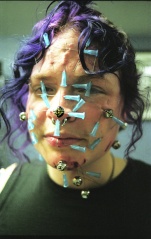
Figure 1. Facial piercing. Note the bleeding on the chin, a common occurrence when piercing is performed on areas of the body with many veins or arteries
Needle play (sometimes known as piercing, play piercing, or needlework) is a form of BDSM play involving the use of medical hypodermic needle tips (such as those shown on the right) to pierce the skin of a submissive or bottom. This can be done to create a psychological or emotional effect, or to create artistic patterns of needles in the flesh of the submissive. Most commonly piercing is done on parts of the body which naturally stick out, such as the nipples or penis, or through pinched-up flesh on the arms, legs, chest, belly, or back.
At the end of each scene all the needles are removed and, usually after a relatively short period of time, the holes close and heal without leaving any scars.
Contents
- 1 Why do it
- 2 The needles
- 3 Who should not try needle play
- 4 Hygiene and preventing infection
- 5 Where to pierce
- 6 How to pierce
- 7 Technique with larger gauge needles
- 8 Removing a needle
- 9 Things to do once needles are in place
- 10 Comparing needle play to other forms of BDSM play
- 11 Notes
- 12 See also
Why do it
Piercing can have a powerful psychological effect on the person being pierced. Many people have a fear of hypodermic needles. Having hypodermic needles thrust through their flesh by their partner can be a very intimate, submissive, and trust-inspiring exercise. Because there is often little or no physical pain involved, it is something the person being pierced will feel more at an emotional or even spiritual level than at a physical or physiological level.
It is also a very intense and symbolic form of penetration where the top or dominant breaks through and enters the skin of their partner.
Some people also practise piercing to create patterns on their partner's body with the needles. This can be similar to decorative rope bondage or branding where patterns can be deliberately created using the bottom or submissive as a canvas. Coloured cotton thread or fine cord can be woven around the needles while they're in place to add colour and enhance the patterns. Fine, detailed needlework can be an exercise and demonstration of a dominant's technical and artistic skill. There can be an element of objectification to this when the submissive is treated only as a canvas for their partner to use.
Finally, using large bore or large gauge needles can be a form of pain play.
The needles
The needles use in needle play are generally disposable hypodermic needle tips of the type used for medical injections or for drawing blood. In their intended role in the hands of doctors or nurses they are usually attached to a syringe---the plunger-like device which contains whatever fluid is being injected or withdrawn.
The needles are meant to be discarded after use and most commonly come in boxes of up to 100, each sealed in its own sterile container.
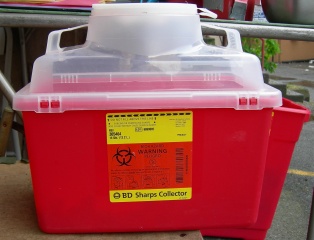
Figure 2. A large sharps container. Note the biohazard symbol. These containers are designed with an opening on top through which used needles can be dropped. However, once inside the needles can't fall back out, even if the container is tipped upside down. The container is also very tough and difficult to open
When you have finished with each needle it should be disposed of in either a specialised "sharps" container (figure 2) or a plastic box with a lid. This is important. They should not just be put in a bin or with other garbage. Some diseases---such as HIV and Hepatitis---can be spread by contact with blood so used needles must be disposed of in a way that prevents people handling them in future from getting pricked.
Hypodermic needle tips and "sharps" containers can be bought from some larger pharmacies or via the Internet.
The needle tips themselves come in different diameters (gauges) and different lengths (see table 1 and figure 3). When talking about needle gauges, the larger the number the smaller the diameter. 17-gauge is commonly used for drawing blood for blood donations and is perhaps too large for needle play unless you are intending to cause serious pain. Sizes around 25-gauge are common for needle play---the holes heal quite quickly and they cause little discomfort. 30-gauge needles are so small that they may not be felt as they are inserted. See below for a chart showing the different sizes. Because the larger gauges are very thin (or fine) and are quite brittle they are only available in shorter lengths to reduce the risk of them breaking as they are inserted.
For needle play the best length will usually be 1½" (32mm) or slightly longer, if available. This allows for a reasonable length of needle in the skin with with space on either side.
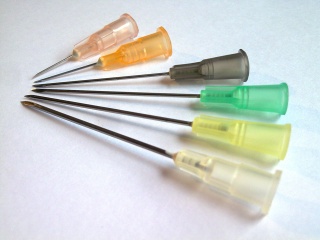
Figure 3. Different gauge needles where the gauge is indicated by the colour of the plastic fitting
Hypodermic needles commonly have a plastic fitting which is used to attach them to a syringe. The colour of this fitting usually indicates the needle gauge.
| Gauge | Outer diameter (mm) |
Colour | Typical lengths available | ||||
| 1/2" (13mm) |
5/8" (16mm) |
1" (25mm) |
1¼" (32mm) |
1½" (38mm) | |||
| 17G | 1.5 | X | X | ||||
| 18G | 1.2 | Pink | X | ||||
| 19G | 1.1 | Cream or white | X | ||||
| 20G | 0.9 | Yellow | X | ||||
| 21G | 0.8 | Green | X | ||||
| 22G | 0.7 | Black | X | X | |||
| 23G | 0.6 | Blue | X | X | |||
| 24G | 0.55 | Purple | X | ||||
| 25G | 0.5 | Orange | X | X | |||
| 26G | 0.45 | Brown | X | ||||
| 27G | 0.4 | Grey | X | ||||
| 30G | 0.3 | Clear | X | ||||
Table 1. Hypodermic needle tip standard sizes
Bevels
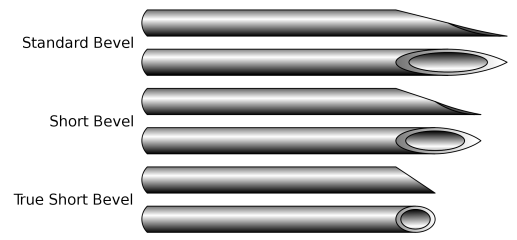
Figure 4. Various needle bevels at the business end of the needle tip
Figure 4 is a diagram which shows some of the different bevels of a needle tip. Instead of being simply cut off flat, the ends of the hypodermic needle tips are cut off at an angle to produce a cutting edge. This allows them to slip more easily into the skin.
Who should not try needle play
Like most of BDSM, needle play should not be practised while drugs or any significant amount of alcohol are in your system. For the person doing the piercing being addled by drugs or alcohol can be very problematic if it affects your aim or if it affects your judgement about what's safe and what isn't. Some drugs, even legal ones like caffeine, can make your hands shake when taken in excess and make it hard to accurately guide a needle into delicate parts of your partner's body.
If you're the one being pierced then some medical conditions and drugs can make needle play inadvisable. If you take aspirin or blood thinners due to blood pressure or heart problems these can reduce your blood's ability to clot. Naturally enough, having needles stuck into you can easily cause you to bleed and it is important that your blood does clot eventually.
Needles sometimes make people faint. Even the sight of needles can do this in some people. If you have low blood pressure, or if you are inclined to faint when you get a needle, then maybe needle play isn't for you. If you absolutely must try it, make sure you are laying down, maybe with your feet elevated to ensure your brain gets plenty of blood. Also warn your partner that you might faint and make sure they will do the right thing and not panic.
Fainting is more likely to occur in a stuffy or poorly-ventilated room.
Hygiene and preventing infection
Unless you commonly share bodily fluids with your play partner (such as by being regular sexual partners without using condoms) you need to take care to ensure that you don't infect your partner with any diseases you might have, and that you don't get infected by anything from your partner. And, even if you do share bodily fluids, you need to make sure that no infections get in through the holes you create.
Wear latex gloves
Because piercing necessarily involves putting holes in people, bleeding is likely, even if it's just a small drop or two. Wearing latex gloves (you can get them from most pharmacies or online) can prevent the blood spreading infection between you and your partner. Even though it might seem like it's one-way protection, latex gloves also prevent the needles and any other equipment you may use from being contaminated by your own sweat (also a bodily fluid) or anything else that might come out of your skin, such as blood plasma through minor scratches or grazes. These can then get into the person you're piercing through the holes you create in them.
Clean and sterilise the parts of the body which are going to be pierced
Use antiseptic or disposable antiseptic wipes on all areas where you'll be placing needles. This will reduce the risk of a needle picking up an opportunistic bug on your partner's skin and carrying it into their body. Disposable antiseptic wipes are available at pharmacies and commonly come in small sealed pouches which you tear open as required.
Be generous with antiseptic. It's better to use too much than not enough.
Only use needles straight out of their packaging
Hypodermic needle tips generally each come sterilised in a small semi-rigid plastic pack sealed with foil. They will have a separate plastic cap protecting the business end of the needle. Open the plastic packs one at a time as you need them. Don't lay the needle tips down on any surface as they might become infected. Don't use needle tips that have been lying around for the same reason. Don't use needle tips from trays whose foil has broken.
Don't re-use needles
They're cheap. It's good practice from a health and hygiene point of view to use a new needle tip, straight out of its sterile container, for each and every piercing. Immediately throw away used needle tips via your sharps container. Don't leave them lying around.
Two very good habits to get into are:
- To automatically safely dispose of the needle tips as you remove them from your partner's body, and
- To automatically reach for a new, sealed tip when you want a needle with which to pierce your partner.
Where to pierce
Because hypodermic needle tips are generally quite small and the holes they create heal very quickly, most parts of the body are potential candidates for piercing. However, areas where there are lots of blood vessels near the surface can provide some excitement as they will often bleed either while the hypodermic needle is in place, or after it is removed, or both (see figure 5). Also, areas where there are lots of nerve endings should be avoided as these can take (much) longer to heal if damaged.
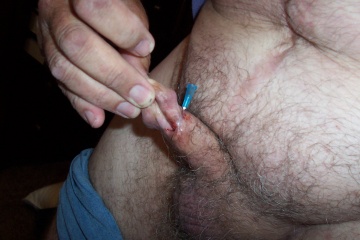
Figiure 5. Single needle piercing the shaft of a penis. Bleeding is common in such parts of the body which are well-supplied with blood.
Be cautious of the following:
- The inside of joints, such as behind the knees, inside the elbows, etc. - there are many blood vessels and sensitive nerves in these locations,
- Penis, vulva, breasts, testicles - there's also a lot of blood in these areas,
- The face - eyes an obvious hazard on the face, but there are many very sensitive areas on the face and many blood vessels close to the surface in the cheeks.
These areas can be good:
- Thighs
- Buttocks
- Arms
- Tummy and navel
- Shoulders
- Chest - particular around or including the nipples
How to pierce
Although the most effective parts of the body to pierce are places like the genitals or nipples, when you first set out to learn how to do piercing you should practice on less sensitive parts of the body. It's useful if your partner has some experience with piercing so they can provide feedback. If you don't have an experienced partner, then practice doing very shallow piercings to begin with (possibly on yourself) on safe areas such as the skin just below the navel, or the thicker skin on forearms or thighs.
Now, in three easy steps:
- Find some skin which you can pinch up between your thumb and forefinger,
- In the other hand, hold the needle only by the plastic fitting and orient the needle so the long edge (see the bevel diagram above) is closest to the skin,
- Briskly push the needle all the way through the fold of flesh, making sure you don't stick yourself.
With practise you can do this without needing to pinch up the skin. I.e., you can do it with one hand.
It can be a good idea to briefly hold your breath while pushing the needle in as this can steady you.
Technique with larger gauge needles
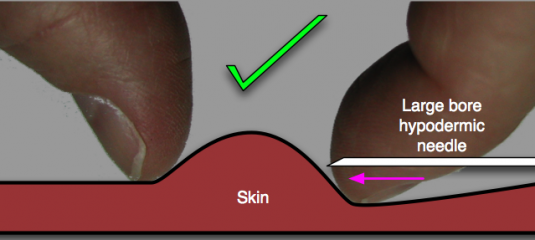
Figure 6
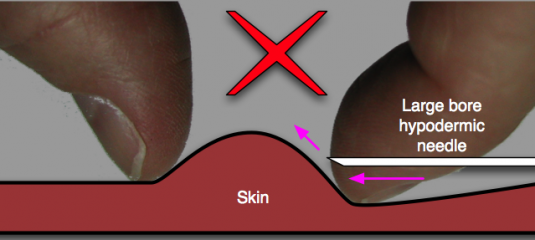
Figure 7
With larger gauge needles it's important that the needle tip be turned so that it will slide into, rather than slide over, the flesh.
The figures on the right show how this is done. Figure 6 is the right way to push a large bore needle through pinched-up flesh. The tip of the needle is turned so that the bevelled edge will immediately "bite" into the skin on contact.
Figure 7 shows the wrong way. The bevelled surface of the tip is parallel to the skin. As the tip is pushed against the skin it can slide up over the skin instead of biting in. Apart from creating an awkward moment, there's a real safety and infection issue here. Because the skin deflects the needle upward there's an increased chance that the tip will go into your finger (or thumb, as could happen in the situation shown in the diagram)
Removing a needle
- If you pinched the skin to get the needle in in the first place, there may be some tension on the needle. If you draw it out without re-pinching up the skin the tip of the needle may cut through the flesh inside as it comes out. Pinch the skin up again if this might be the case before removing,
- Draw the needle straight back out a brisk and smooth movement,
- As a precaution against infection, and especially if there's any bleeding, you may want to apply a small antiseptic pad briefly to the site.
Note that swabbing the area with a disinfectant or alcohol after removing a needle can sting.
As needles are removed there can be some subcutaneous bleeding. This is blood being released into the tissue around the hole and this can cause bruising.
Things to do once needles are in place
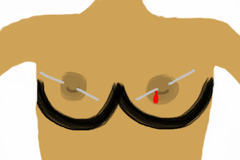
Figure 8
Actually piercing your partner with one or more needles may not be the end of it as far as your scene goes. Some people combine piercing with other activities such as bondage, sensation play or pain play.
In terms of bondage, one of the things which piercing does is that it creates anchor points which can be used for bondage or to attach things. For example, once a nipple has been pierced by a long needle, such as shown in the illustration on the right, you can easily loop thread or string around the needle so as to pull on the nipple. You can attach small weights, or you can even attach small bells to the submissive's nipples in this way so that when they move or walk around you can hear little tinkling noises.
Some tops or dominants will use multiple piercings through the shaft of their bottom's or submissive's penis as anchor points for decorative ribbons. When there are also matching piercings on the male submissive's stomach, the whole length of the penis can be laid against the stomach and can be bound, via the piercings, to the needles on the tummy.
While one of the main points about using hypodermic needle tips is that they're designed to be as pain free as possible, they are, after all, needles, and they can be used to create pain or sensation. These can be created with these needles in a few different ways:
- Use a large bore, or large gauge needle. The finer the needle, the more likely it is to avoid nerve endings and to make it through the skin without causing any pain. Using larger diameter needles makes this less of a possibility and, as noted above, the actual tips of the needles are designed so they cut their way through the flesh. In addition, instead of using a brisk stroke to get the needle through the skin quickly, you can also just slowly push it through the flesh so as to prolong the agony.
- Pick somewhere very sensitive. Areas of the body like the forearms, stomach, penis, and even the nipples, can be remarkably robust and resistant to pain. If you're going for pain, use somewhere much more sensitive, such as scrotum, the fleshy part under the tongue, the soft skin on the sole of the foot, or the slight webs of skin between the fingers and toes. Be creative.
- Once a needle is in place, you can pull on it and twist it to create sensation or pain. Be careful with this in regards to infection because although skin will naturally close around the needle once it's in place, when you wiggle or move the needle you open up the hole again. Be sure to use plenty of disinfectant.
- Again, once a needle is in place, you can squeeze the part of the body with the needle through it (e.g., nipple) so as to press the flesh inside the skin against the bare metal running through it.
- Because needles are typically made of metal, and because metal conducts electricity, needles can become useful places where you can focus the attention of electrical play.
Comparing needle play to other forms of BDSM play
Probably the most common forms of BDSM play fall into one of the categories of bondage, impact play, or pain play. Needle play doesn't fit into any of these because there's no restraint involved, it doesn't involve striking or hitting, and because even though it involves needles these are hypodermic needles and they're specifically designed not to hurt.
Perhaps what we can say is that needle play is an intense form of penetration. It requires the submissive or bottom to place themselves, unmoving, in the hands of their partner as their partner quite literally penetrates them with the sharp needles. There is, of course, a strong element of surrender to this. Not only is there surrender to being pierced, but there's also a necessary surrender to the man-handling involved as the person being pierced is positioned, and as their skin is pinched up each time a needle is slipped through.
Another significant difference with some other forms of BDSM play is that although it's very definitely a physical activity which requires a lot of skill and attention to safety, at the end of a piercing scene there are no marks or scars. There may be the occasional bruising from subcutaneous bleeding (bleeding under the skin), but otherwise the effect is almost completely psychological.
Probably the closest comparable activities are some types of cutting where the knife only penetrates through a couple of the outer layers of skin and there is no bleeding, or wax play even though this doesn't actually involve penetrating the skin at all.
Notes
- Two 18-gauge needles crossed through the lips will prevent a disobedient submissive from talking.
- Be very careful when using needles as anchor points during bondage. They can easily tear out through the skin if they are pulled too hard.
- If your partner is moving about with the needles in place the ends of the needles may abrade on their skin and cause irritation or bleeding.
- Try wiggling a needle that is already in place to see your partner's reaction.
- Never touch the sharp of the end of the needle, or allow it to come into contact with anything. This end must remain clean and sterile for when it is removed (i.e., the tip may travel back through the skin carrying germs).
- Some submissive's will hold their breath when a needle is being pushed in. This is OK because it both steadies their bodies and often helps them focus, however make sure they start breathing again straight away. Some submissives will be so focused that they forget to start breathing again, and when they do it is with a big gasp which can seriously affect a piercing-in-progress.